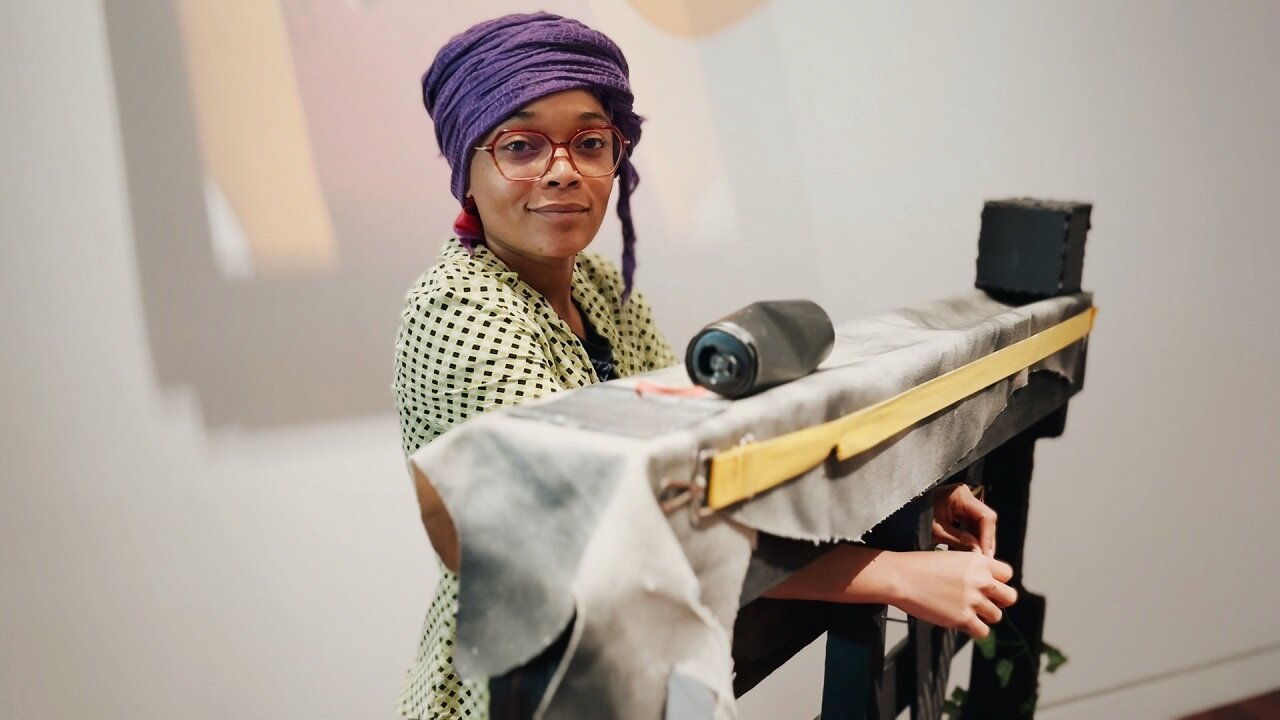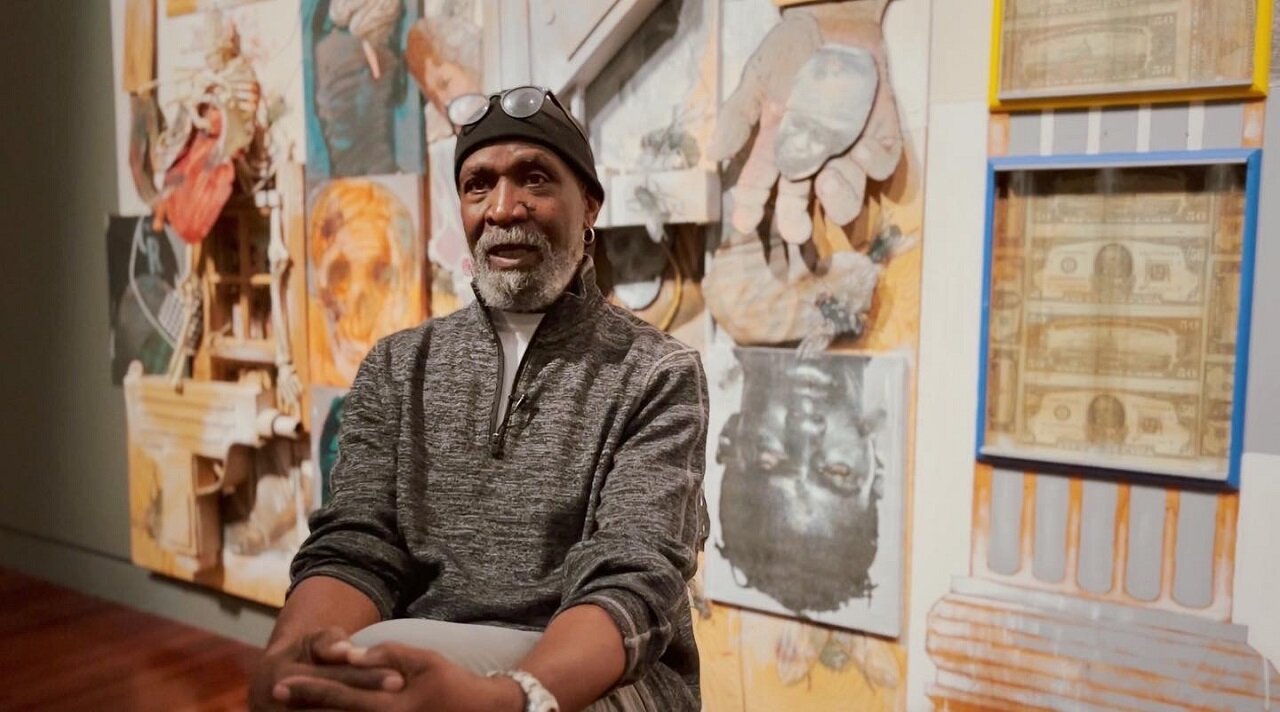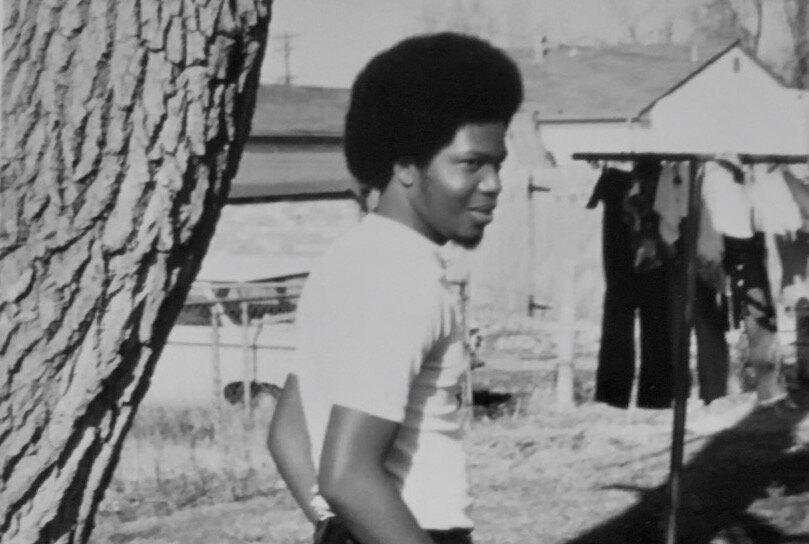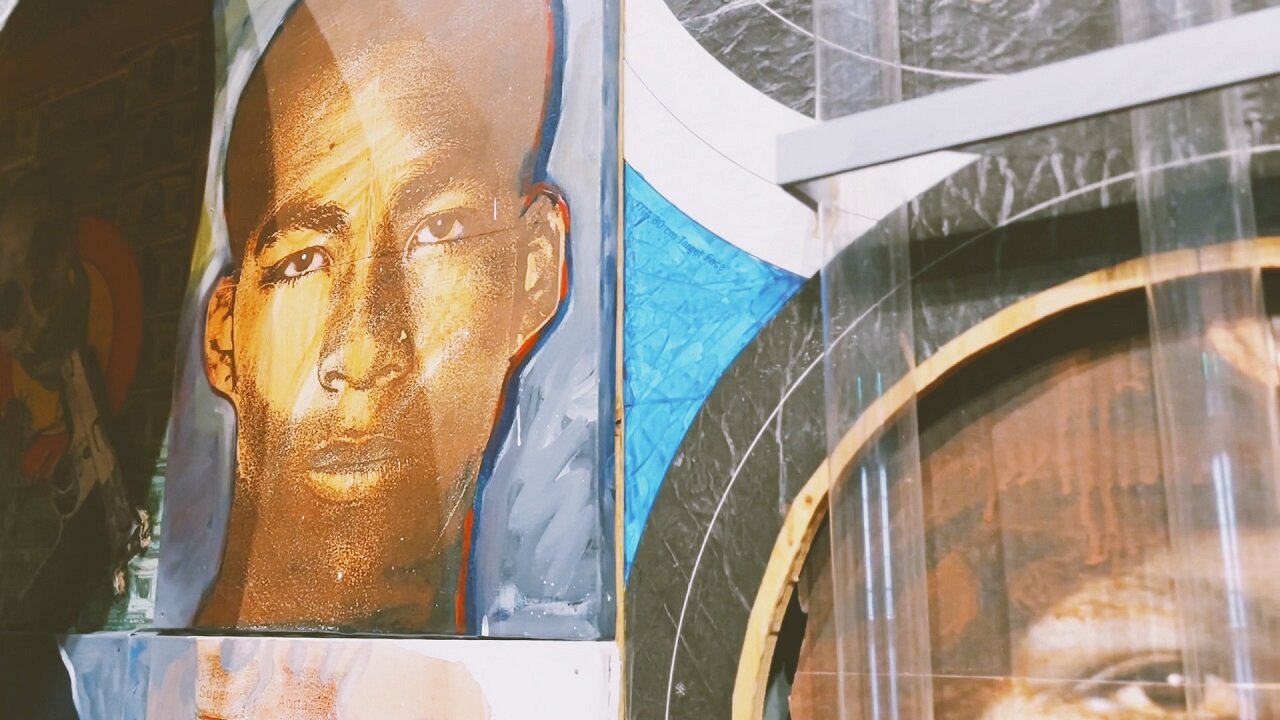Gun violence at the heart of collaborative exhibit with Floyd D. Tunson

COLORADO SPRINGS, Colo. — Floyd D. Tunson’s large-scale “Hearts and Minds” — a 26’ by 13’ gift from the artist — is the centerpiece of a collaborative exhibit of the same name.
It’s on display on the second floor El Pomar South Gallery at the Colorado Springs Fine Arts Center at Colorado College through July 9.
“Hearts and Minds” was created as part of Tunson’s Endangered series, a larger body of work addressing gun violence and “the endangerment of being in this society as a young Black male,” said Tunson.
The massive “Hearts and Minds” materialized over time in response to the killing of the artist’s youngest brother, Randolph Tunson.
“‘Hearts and Minds’ started after the shooting of my brother by the Denver Police in City Park in 1974,” Tunson said.
Tunson named Randolph as the most talented artist in his large, creative family. “He had been diagnosed as a schizophrenic and had mental illness,” Tunson said. “Many times, I would go to Denver and make sure he was on his meds.”
Experiencing the repercussions of his brother’s death and seeing its effects on his family and community, Tunson concentrated his art practice on the principles of endangerment.
The panels of “Hearts and Minds” highlight Tunson’s expansive, multi-disciplinary career in abstract and figurative painting, drawing, photography, mixed-media, installation and sculpture work.
Bold colors relay the panic, urgency and definitive loss of endangerment. Handguns lord over scenes depicting hearts, minds, lives, internal and external strife, prison bars, and surface and subsurface impacts.
Created over several years in the early 1990s, Tunson donated the piece to the Fine Arts Center in 2020.

Museum Director Michael Christiano said discussions about how to display “Hearts and Minds” led to expanding the show to highlight student and community voices.
Christiano added that the exhibit was a “focused opportunity to present the work, celebrate the generosity of the artist, and position it as a catalyst to inspire dialogue with other members of our community.”
Colorado College and Colorado Springs School District 11 students were introduced to Tunson’s work, held discussions, engaged in collaborative processes and met the artist. Student artwork, including collage, diorama, visual and found art, were installed directly reflecting Tunson’s “Hearts and Minds” on adjacent gallery walls.

Graduating senior LaNiah Moor created a response to Tunson’s work as part of her thesis project for Colorado College. In her work, titled “The Never-Ending Spillage (an infinite series of collaborative projects),” Moor “wanted to make something that encapsulates how I look at the world,” she said.
A series of pallets along with found and donated objects became an interactive sculpture. Moor said her piece can be manipulated by the audience, changing their experience with space.
“The experiences I’ve had in the past five years have been up and down,” Moor said of her time at college. “Sticking through with things, being resilient, collecting things, making use of things that are around you — can make the most beautiful things,” she said. She explained her work reflects the duality of both “generational trauma and abundance.”
“I wanted to make something that embodied all of that,” Moor said.
A collaborative performance piece inspired by Tunson’s work is also part of exhibit offerings. Music by Tomás Doncker & The True Groove All-Stars, with lyrics from Pulitzer Prize-winning poet Yusef Komunyakaa and visuals by filmmaker and videographer William Murray will be site-specific at the Fine Arts Center on June 17 and at Armstrong Hall June 18.
A video-based presentation of the collaboration by Murray, also titled “Endangered,” is available to view in a seated space within the gallery through the exhibit’s duration.
And that’s not all — Colorado Springs is just one stop on the summer’s “Tunson Takeover,” as Tunson’s longtime manager Wylene Carol refers to his trio of concurrent Colorado exhibitions.
A 50-year retrospective of Tunson’s work, “Floyd D. Tunson: Ascent” spans two Denver metro galleries this summer: through August 28 at the Arvada Center for the Arts & Humanities and through July 31 at RedLine Contemporary Art Center. Tunson will also present at the History Colorado Center in a lecture event July 21.

In an interview with Rocky Mountain PBS, Tunson remembered a childhood of artistic emergence and family support. He grew up with nine siblings in Denver’s Five Points neighborhood, then moved to the Platte Valley Projects.
His dad had two jobs, and his mom took care of a doctor’s family and their children, in addition to their family, Tunson explained. Growing up, his parents supported his pursuit of the arts. He remembers his mother desperately trying to find a suitable arts program for him to attend in the summer.
Tunson was drafted into the military and went to basic training, then Officer Candidate School. In his last week before graduating as a second Lieutenant, Tunson said "for the second time in the history of the Army, they had trained too many reserve officers because of Vietnam.”
Tunson said he’d already received orders to become a combat engineer platoon leader in Vietnam — “which probably had a life expectancy of about two weeks,” he was told.
He was presented with an option: resort to enlisted status and choose where to go, or graduate with Lieutenant’s bars.
It was an easy choice, Tunson said. He chose to stay in the U.S., thinking “anywhere they sent me in the States would be better than Vietnam,” he said. While on leave, Tunson applied for a job at District 11. He was released from the military 11 months early to become their next art teacher.
For 30 years, Tunson’s career as an artist ran parallel with his teaching career. Living in Manitou Springs, he taught art at Palmer High School in downtown Colorado Springs, instructing by day and creating by night. Tunson said his routine was to go home after school, take a nap, get up and work on his practice past midnight.
His whole family was creative, Tunson said. Among ten siblings, several were talented artists including his older brother — Tunson’s artistic mentor.

“He was the one who made me understand it was possible to do more than one thing in art,” Tunson said. “He used to sit on the couch and paint. I would sit on the arm of the chair. For as long as he was there working, I was on the arm of the chair, observing.”
As they grew up, Tunson said his youngest brother, Randolph, emerged as “probably the most gifted of all of us,” Tunson said. “Prior to the shooting, I was getting ready to bring him down to Colorado Springs. I was going to teach him how to oil paint.”
Randolph’s death at the hands of Denver Police in City Park in 1974 at the age of 22 prompted the creation of “Hearts and Minds” in phases over several years.
“‘Hearts and Minds’ is, hopefully, that your mind and your heart are in conjunction to do the right thing,” Tunson explained.
Tunson created the center panel first. He realized he wanted to add to it while seeing it on display at Robischon Gallery in Denver.
“Looking at it in the gallery, I realized I felt like I had more to say,” Tunson said. The piece eventually grew to over three times the size.
Tunson reflects on “Hearts and Minds.” “This could still grow,” he said. “Sadly, this is still relevant. I could still add more parts to it. What’s going on in society in relationship to this has not come to an end. It makes it too relevant.”
“Floyd D. Tunson: Hearts and Minds” can be seen in person through July 9, 2022, at the Colorado Springs Fine Arts Center at Colorado College, 30 W Dale St, Colorado Springs.

Kate Perdoni is a multimedia journalist with Rocky Mountain PBS and can be reached at kateperdoni@rmpbs.org.